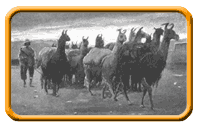 Packing with Llamas Packing with Llamas
Llamas' intelligence, natural agility and calm disposition make them
outstanding pack animals. For 5000 years llamas have been used to transport goods
across the rugged Andes in South America. Today they are found across the United States
and Canada carrying loads for North American back country travelers. Here,
llamas serve
as the pack of choice in situations that call for minimal impact, ease in handling, agility and
surefootedness.
Backpackers, outdoor photographers, mountain
climbers and public agency field crews use llamas to take the load off their own backs. High country
fishermen enjoy casting across alpine lakes in float tubes packed in by
their llamas. Hunters successfully employ llamas to pack game out of rugged
areas that would be inaccessible to horses and mules. Families with small
children have trained their llamas to accept a lightweight rider, enabling their youngsters
to take longer backcountry journeys. Commercial llama packers have led scores of
adventurous travelers on truly unique outdoor vacations with the support of their
woolly packing companions.
Llama Packing
Male llamas in good physical condition are best suited to packing. Both
intact and gelded male llamas make excellent packers. Many owners choose to
have their pack llamas gelded unless they will be using them for breeding.
Once a llama has learned to follow on a slack lead he can begin the steps to
become a pack llama. During the early lessons he should learn to accept the
saddle on his back and cinches around his belly and chest before he is loaded with saddle bags
(panniers) with weight. Additional training should include learning to load easily into a trailer,
allowing his feet to be picked up for toe nail trimming and inspection, and general acceptance
of being close to people once on a halter and lead rope.
The distance a pack llama can travel is affected by his condition,
newness to packing, weight of load and terrain. A seasoned pack llama that is
moderately loaded (about 25% of his body weight, providing he is fit and not obese)
and in excellent physical condition should be able to walk 12 to 28 miles
on well maintained trail. Game trails (sheep, deer, elk, etc.) or rough
terrain requiring extra agility and physical exertion should be taken into
account and expectations for a day's travel should be less than on a well
maintained surface. Llamas seem to appreciate rest stops along the way about every
hour or so.
When llamas are between two and three years old
they may
begin carrying lightweight loads. Full adults of more than three years of age should be
able to carry 25 to 30% of their body weight providing they are in good
condition. Each animal has a maximum weight, not all llamas are the same
in their carrying capacity and willingness to carry a heavy load.
Llama Packing Equipment
A variety of pack systems have been developed specifically for llamas.
These usually consist of a saddle and two pack bags known as panniers. Some
systems also have top loading stuff bags that are part of the pack system.
Good pack saddles offer adequate padding, avoid pressure
on the spine, and are very stable allowing for slightly different weights
in each saddle
bag without shifting and moving while the animal walks. The Bonny
Doon system has
been perfected over 25 years to achieve an optimum saddle. See the details
of
the Bonny Doon Pack System's Larrabee Pack. Pay special attention to the
saddle and the insertable aluminum frame that can be contoured individually to fit
each animal.
Transporting Llamas to the Trailhead
Pick-ups with large camper shells, vans, lightweight but fully enclosed
trailers with adequate ventilation are common conveyances used to transport
llamas. Stock trailers used for cattle are popular with the bigger outfitters.
Trip Preparation and Preventive Care
The key to successful llama packing is working with a healthy,
well-conditioned and well-trained llama. A pre-packing conditioning
program should include regular walks where the llama's respiration rate and
general response to walking can be assessed and improved, if necessary. All
llamas must receive annual vaccinations, deworming and good diet. Vaccinations a
few days before a trip or a marked change in diet just before a trip are not
wise. A llamas health should be considered year round for optimum performance on the trail.
Some types of plants you may encounter may be poisonous. Each
region has
different kinds of plants. The ability to identify poisonous plants is
essential. Check with authorities in the region you've chosen to visit
with your llama. Oleanders, Death Camas, and some types of ferns are particularly
deadly. Other toxic plants may not kill but will upset an animals digestive
system and end a trip. It is smart to know the plant hazards. Other toxic dangers
include
poisonous snakes and insects.
On the Trail
Packing with llamas is an unforgettable experience. Besides taking the
load off your back a llama's highly curious and observant nature will enhance
your experience in nature.
Llamas like to pack in a group. They are often strung together in a
single file. Animals actually develop preferences about where they want to be in a
string of animals. Llamas seem to perform better in groups, though individual
animals are sometimes used by packers. However, there are numerous advantages
to traveling with a group of llamas. If one animal becomes ill or weak,
its load can be shifted to other animals. An animal can be designated to
carry supplemental feed for areas in which forage is too sparse.
Care needs to be taken in "typing out llamas." They generally respect a
picket line or lunge rope, but a weak link in the rope needs to be provided
should an animal react to a predator or other danger and run exposing the
animal to a potential broken neck. Better to catch your llama than bury
him, should an unusual situation occur. Llamas breaking free of lunch lines
will stay near camp and other llamas, so a "free" llama is readily
"catchable." Llamas should always be picketed within site of camp.
Special precautions need to be taken when meeting horses and mules on the
trail. Llamas are almost always calm and react with curiosity. Sometimes horses
panic because some mule/horse packers do not select their animals carefully.
"Easy scare horses" often react poorly to deer and other animals they
meet, but with llamas the wisest action when coming to a string of horses is to
simply pull off of the trail and stand silently to let the horses pass.
It can be very difficult to control a panicked horse, so horses
/mules should
always be given the right of way.
Llamas travel silently on padded feet, produce small amounts of
unobtrusive dung that looks like rabbit pellets and they are browsers.
Overall, llamas create minimal environmental impact compared to other forms of livestock and people.
Packing with llamas is fun, exciting and memorable. It requires
responsibility on the part of the person in charge. To the experienced llama trekker
there is no "high" like cruising through the back country
for a few days with a group of
llamas and good friends.
Acknowledgement: Much of the body of this text came from "Packing with
Llamas," ILA Educational Brochure #10 written by Stanyln Daughtery. We
are grateful for ILA and Stanyln for providing this information for the use
of llama enthusiasts.
|





